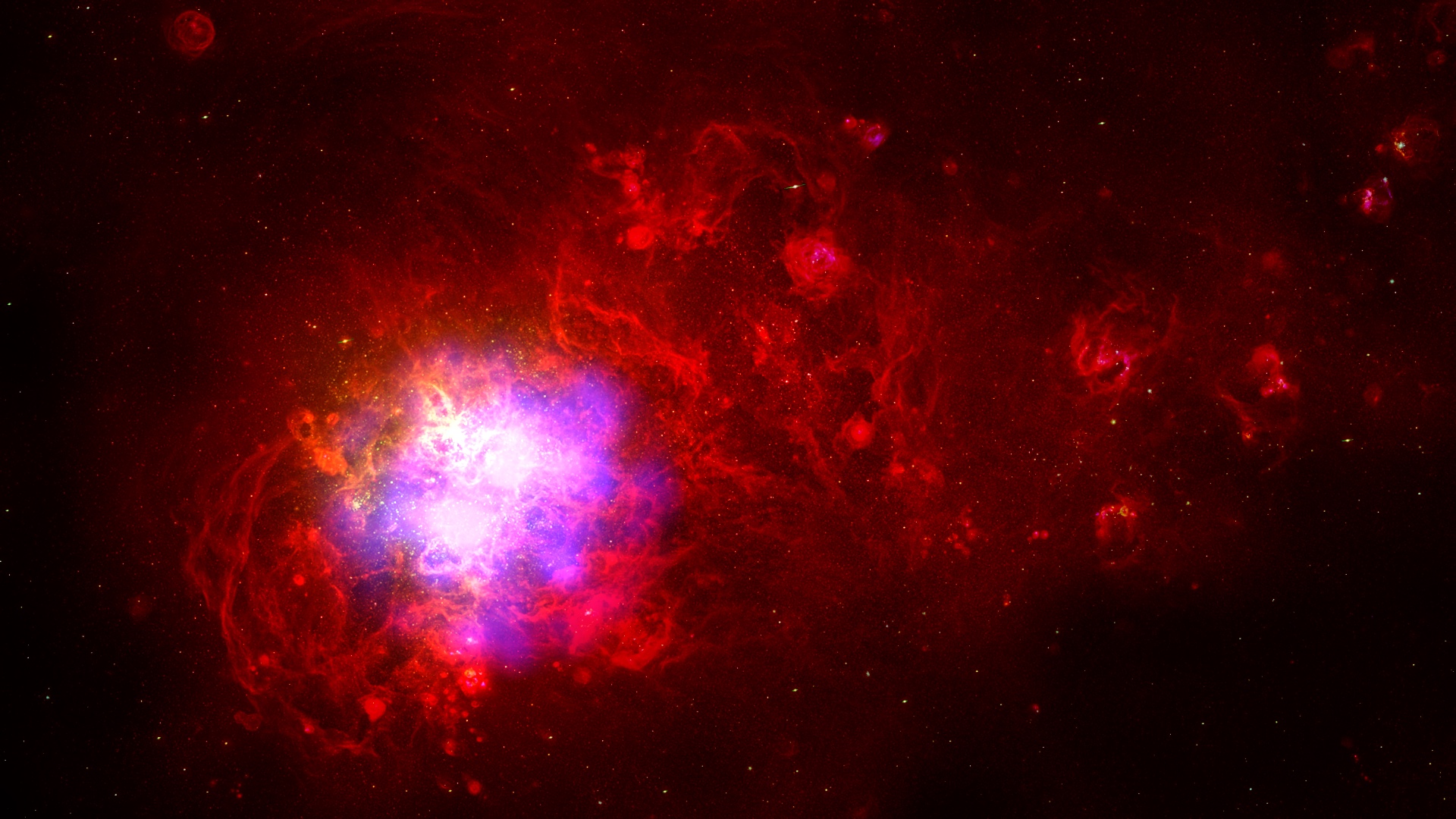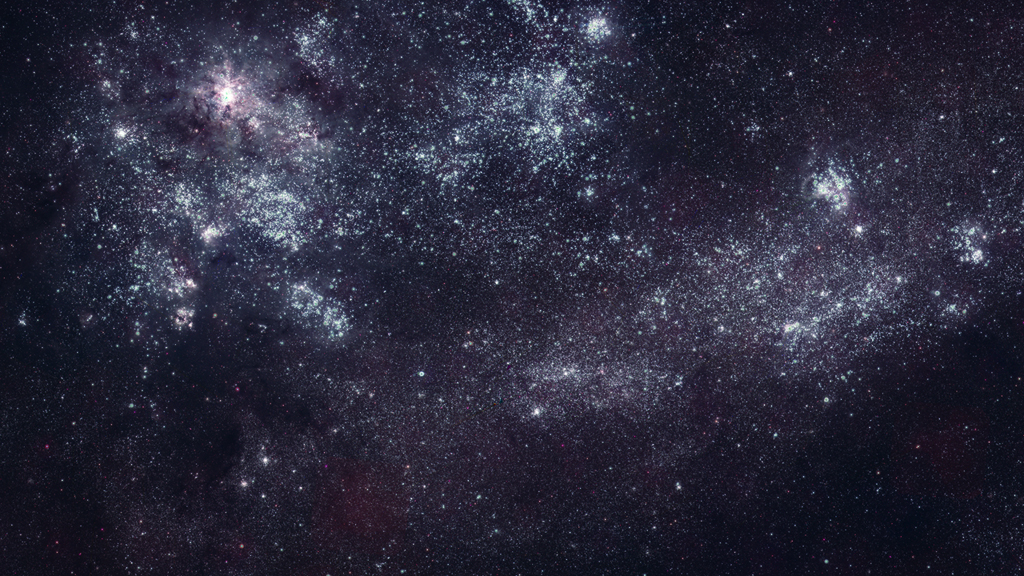NASA Swift Provides the Best-Ever UV View of the Nearest Galaxies
Astronomers at NASA's Goddard Space Flight Center in Greenbelt, Md., and the Pennsylvania State University in University Park, Pa., have used NASA's Swift satellite to create the most detailed surveys of the Large and Small Magellanic Clouds, the two closest major galaxies, in ultraviolet light.
Thousands of images were assembled into seamless portraits of the main body of each galaxy to produce the highest-resolution surveys of the Magellanic Clouds at ultraviolet wavelengths. The project was proposed by Stefan Immler, an astronomer at Goddard.
The Large and Small Magellanic Clouds, or LMC and SMC for short, lie about 163,000 and 200,000 light-years away, respectively, and orbit each other as well as our own Milky Way galaxy.
Compared to the Milky Way, the LMC has about one-tenth its physical size and only 1 percent of its mass. The SMC is only half the size of the LMC and contains about two-thirds of its mass.
The new images reveal about a million ultraviolet sources within the LMC and about 250,000 in the SMC.
Viewing in the ultraviolet allows astronomers to suppress the light of normal stars like the sun, which are not very bright at these higher energies, and provide a clearer picture of the hottest stars and star-formation regions.
Only Swift's Ultraviolet/Optical Telescope, or UVOT, is capable of producing such high-resolution wide-field multi-color surveys in the ultraviolet. The LMC and SMC images range from 1,600 to 3,300 angstroms, UV wavelengths largely blocked by Earth's atmosphere.
The Large and Small Magellanic Clouds are readily visible from the Southern Hemisphere as faint, glowing patches in the night sky. The galaxies are named after Ferdinand Magellan, the Portuguese explorer who in 1519 led an expedition to sail around the world. He and his crew were among the first Europeans to sight the objects.
Watch this video on YouTube.
New surveys conducted by NASA's Swift provide the most detailed overviews ever captured in ultraviolet light of the Large and Small Magellanic Clouds, the two closest major galaxies to our own. Swift team member Stefan Immler, who proposed the imaging project, narrates this quick tour. All visible light imagery provided by Axel Mellinger, Central Michigan University
For complete transcript, click here.

This version of the Swift LMC mosaic is co-aligned with the optical image below.
Credit: NASA/Swift/S. Immler (Goddard) and M. Siegel (Penn State)

This optical view of the LMC is co-aligned with the Swift UV image above.

This is the Swift LMC mosaic at full resolution. Nearly a million ultraviolet sources appear in this mosaic of the Large Magellanic Cloud, which was assembled from 2,200 images taken by the Ultraviolet/Optical Telescope aboard NASA's Swift satellite. The 160-megapixel image required a cumulative exposure of 5.4 days. The image includes light from 1,600 to 3,300 angstroms — UV wavelengths largely blocked by Earth's atmosphere — and has an angular resolution of 2.5 arcseconds. Viewing in the ultraviolet allows astronomers to suppress the light of normal stars like the sun, which are not very bright at these higher energies, and provides a clearer picture of the hottest stars and star-formation regions. The LMC is about 14,000 light-years across. The image is oriented with north at top.
Credit: NASA/Swift/S. Immler (Goddard) and M. Siegel (Penn State)

This is the Swift SMC mosaic at full resolution. About 250,000 ultraviolet sources appear in this mosaic of the Small Magellanic Cloud, which was assembled from 656 images taken by the Ultraviolet/Optical Telescope aboard NASA's Swift satellite. The approximately 15-megapixel SMC image has a total exposure time of 1.8 days. The image includes light from 1,600 to 3,300 angstroms — UV wavelengths largely blocked by Earth's atmosphere — and has an angular resolution of 2.5 arcseconds. Viewing in the ultraviolet allows astronomers to suppress the light of normal stars like the sun, which are not very bright at these higher energies, and provides a clearer picture of the hottest stars and star-formation regions. The SMC is about 7,000 light-years across. The image is oriented with north at top.
Credit: NASA/Swift/S. Immler (Goddard) and M. Siegel (Penn State)

The LMC as it appears in visible light. The galaxy's most prominent object is the sprawling Tarantula Nebula (middle left), the largest star factory in the LMC and the most active star-formation zone among the dozens of galaxies that make up the Local Group, which includes our own Milky Way and the Andromeda galaxy (M31). The LMC is about 14,000 light-years across.

This visible light mosaic shows the LMC and SMC in context with the plane of our own galaxy, the Milky Way. Dusty filaments create dark traces across the bright central plane of the Milky Way, visible across the top of the image. Below it, separated by about 21 degrees, lie the LMC and SMC, the closest major galaxies to our own. Lying about 163,000 and 200,000 light-years away, respectively, the LMC and SMC orbit each other as well as our own Milky Way galaxy. The LMC is about one-tenth the size of the Milky Way and contains only 1 percent of its mass. The SMC is half the LMC's size and contains about two-thirds of its mass.

This visible light mosaic shows the LMC and SMC. Separated by about 21 degrees, the two galaxies are readily visible from the Southern Hemisphere as faint, glowing patches in the night sky. The LMC and SMC are the closest major galaxies to our own and lie about 163,000 and 200,000 light-years away, respectively.

An annotated version of the Swift LMC mosaic that identifies a sampling of astronomical objects.
Credit: NASA/Swift/S. Immler (Goddard) and M. Siegel (Penn State)

An annotated version of the Swift SMC mosaic that identifies a sampling of astronomical objects.
Credit: NASA/Swift/S. Immler (Goddard) and M. Siegel (Penn State)
For More Information
Credits
Please give credit for this item to:
NASA's Goddard Space Flight Center. However, individual images should be credited as indicated above.
-
Animator
- Scott Wiessinger (USRA)
-
Video editor
- Scott Wiessinger (USRA)
-
Narrator
- Stefan Immler (UMCP)
-
Producer
- Scott Wiessinger (USRA)
-
Scientist
- Stefan Immler (UMCP)
-
Writer
- Francis Reddy (Syneren Technologies)
Release date
This page was originally published on Monday, June 3, 2013.
This page was last updated on Wednesday, May 3, 2023 at 1:52 PM EDT.
Missions
This visualization is related to the following missions:Series
This visualization can be found in the following series:Tapes
This visualization originally appeared on the following tapes:-
Swift SMC and LMC UV Mosaics
(ID: 2013045)
Monday, June 3, 2013 at 4:00AM
Produced by - Robert Crippen (NASA)
Datasets used in this visualization
-
[Swift]
ID: 217
Note: While we identify the data sets used in these visualizations, we do not store any further details, nor the data sets themselves on our site.


